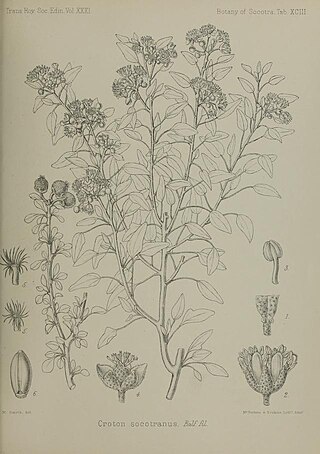
Ricinodendreae is a tribe of the subfamily Crotonoideae, under the family Euphorbiaceae. It comprises 3 genera.
Lobanilia is a plant genus of the family Euphorbiaceae and the sole genus of the subtribe Lobaniliinae. It was first described as a genus in 1989 and is endemic to Madagascar.
- Lobanilia asterothrixRadcl.-Sm.
- Lobanilia bakeriana(Baill.) Radcl.-Sm.
- Lobanilia claoxyloidesRadcl.-Sm.
- Lobanilia crotonoidesRadcl.-Sm.
- Lobanilia hirtella(Baill.) Radcl.-Sm.
- Lobanilia luteobrunnea(Baker) Radcl.-Sm.
- Lobanilia ovalis(Baill.) Radcl.-Sm.
Claoxylopsis is a plant genus of the family Euphorbiaceae, first described as a genus in 1939. The entire genus is endemic to Madagascar.
- Claoxylopsis andapensisRadcl.-Sm.
- Claoxylopsis perrieriLeandri
- Claoxylopsis purpurascensRadcl.-Sm.
Amyrea is a plant genus of the family Euphorbiaceae first described as a genus in 1941. It is native to Madagascar and to nearby Mayotte Island in the Indian Ocean.
Stachyandra is a plant genus in the family Picrodendraceae first described as a genus in 1990.

Piranhea is a plant genus under the family Picrodendraceae described as a genus in 1866.

Pseudolachnostylis is a genus of plants in the family Phyllanthaceae first described as a genus in 1899. It contains only one known species, Pseudolachnostylis maprouneifolia native to central and southern Africa. Its common name is kudu berry, though the term also applies for Cassine aethiopica. In Zimbabwe it is called mutsonzowa (Shona) or Umqobampunzi (Ndebele).
Lingelsheimia is a plant genus in the families Phyllanthaceae, first described as a genus in 1909. It is native to central Africa and Madagascar.
- Lingelsheimia abbayesii(Leandri) Radcl.-Sm. - Madagascar
- Lingelsheimia ambigua(Leandri) Radcl.-Sm. - Madagascar
- Lingelsheimia fiherenensis(Leandri) Radcl.-Sm. - Madagascar
- Lingelsheimia frutescensPax - Gabon, Zaire
- Lingelsheimia manongarivensis(Leandri) G.L.Webster - Madagascar
- Lingelsheimia sylvestris(Radcl.-Sm.) Radcl.-Sm. - Tanzania
Sibangea is a plant genus of the family Putranjivaceae, first described as a genus in 1883. It is sometimes included in Drypetes. It is native to central Africa.
Andrachne schweinfurthii is a species of plant in the family Phyllanthaceae. It is endemic to Yemen. Its natural habitats are subtropical or tropical dry forests and rocky areas.
Lannea transulta is a species of plant in the family Anacardiaceae. It is endemic to Yemen. Its natural habitats are subtropical or tropical dry forests and subtropical or tropical dry shrubland.

Lannea is a genus of plants in the family Anacardiaceae.
Paranecepsia alchorneifolia is a plant in the family Euphorbiaceae. It is native to southeastern Africa.
Spiniluma is a genus of flowering plant in the family Sapotaceae. The genus is native to Eritrea, Ethiopia, Saudi Arabia, and Socotra.
Cnidoscolus regina, synonym Victorinia regina, is a species of plant in the family Euphorbiaceae. It is endemic to Cuba.

Hans Schinz was a Swiss explorer and botanist who was a native of Zürich.
Philipp Wilhelm Albrecht Zimmermann was a German botanist. He was a Professor of Botany at several different Universities . He was a botanist and collector of fungi and spermatophytes, who worked in Indonesia and Tanzania from 1902 to 1919. He moved to Indonesia in 1896 and studied applied botany. In 1902 he moved to Africa to join the Amani Research Institute that was established that year. He returned to Germany after World War I in 1920. He wrote about the cultivation of coffee among other things related to botany, but most of his writings were destroyed during World War II.

Croton socotranus is a species of flowering plant in the family Euphorbiaceae, native to Socotra. A shrub, it is dominant in the meterhel croton shrubland, co-dominant in the shirmihin d'efer mixed deciduous shrubland, and is found in many other shrubland biotopes.

Paranecepsia andrafiabensis is a tree in the family Euphorbiaceae. It is a critically endangered species, endemic to Madagascar. The species is named for the village of Andrafiabe in Diana Region.







